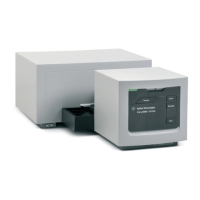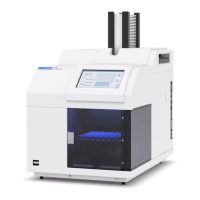Agilent 8453 UV-visible Spectroscopy System Operator’s Manual 43
Good Measurement Practices 3
General Considerations
Apertured Cells
In applications where sample volume is limited, apertured or microcells are
used. The width of these cells is reduced to reduce the volume and the blank
part of the cell must be blackened to avoid unwanted transmission and
reflection through the side walls. If the side walls are not blackened the result
will be poor photometric accuracy and, if different concentrations are
measured, poor linearity.
The disadvantage of apertured and microcells is that part of the light beam is
blocked. Not all the light passes through the sample and there can be some loss
in sensitivity. See Figure 5 for recommended and Figure 6 for cells you should
not use with the instrument.
Figure 5 Recommended Cells
Quartz cells
Quartz cells with black apertures*
CAUTION
* Quartz cells with black apertures smaller than 2 mm, when used with a multicell
transport, can lead to measurements of poor reproducibility.

